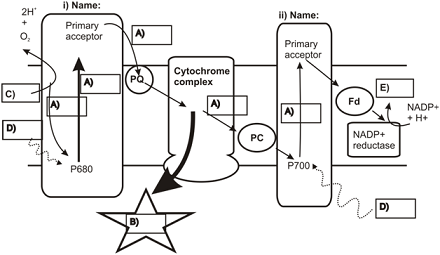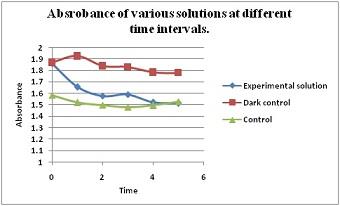SLE132 Biology - Form And Function - Deakin University
DO YOU WANT TO EXCEL IN SLE132 BIOLOGY - FORM AND FUNCTION ASSIGNMENT - ORDER AT EXPERTSMINDS!
1. What is the chemical species that is transferred through the light reactions? (Box A)
Answer: electron (e-)
2. What energy-rich compound is produced by the actions of the cytochrome complex? (Box B)
Answer: Energy for synthesis if ATP
3. What is the compound (Box C) used to donate electrons to the photosystems, and which gives rise to 2H+ and O2?
Answer: The enzyme system that catalyzes water splitting contains magnesium and calcium and situated in photosystem II of chloroplast.
4. What energy is used to energise the light reactions? (Box D)
Answer: Light energy
5. What is the product of the reaction that is occurring at NADP+ reductase? (Box E)
Answer: NADPH
6. Provide names for structures i and ii? (0.5 mark for each correct answer)
Answer: i= Photosystem II
Ii = Photosystem I
7. The electron-accepting dye, DCPIP, substitutes for which compound in your prac 4, part B experiment?
Answer: DCPIP substitute NADP+ in experiment 4 part B.

SAVE YOUR HIGHER GRADE WITH ACQUIRING SLE132 BIOLOGY - FORM AND FUNCTION ASSIGNMENT HELP AND QUALITY HOMEWORK WRITING SERVICES OF EXPERTSMINDS.COM!
Introduction: In one paragraph (250 words or less) provide a brief introduction to your experiment (5 marks). Use the following description and questions and the concept map on the previous page to guide you. Provide an overview of photosynthesis by describing the purpose of the light and dark reactions. How do the light and dark reaction contribute to photosynthesis? Describe the products and by products of the light reactions and the general concept of the system. What part of the system does the DCPIP substitute?
Answer: Photosynthesis is the process known to produce starch and molecular oxygen from atmospheric carbon-dioxide and water by using light and chlorophyll pigment. But the chemical reactions takes place during photosynthesis is not so simple. The reaction of photosynthesis consists of light reaction and dark reaction. In light reaction, light drives flow of electrons and produces ATP, NADPH and molecular oxygen. The energy (ATP and NADPH) is used in the dark reaction to produce glucose from carbon-dioxide by the reaction of Calvin cycle (Lambers et al., 2008).
Light reaction is completed in two photosystems; photosystems I and photosystem II. Light absorption by chlorophyll and other photosynthetic pigments is the first step of photosynthesis. This light absorption initiates flow of electrons by various electron acceptors and terminates at NADP+. Due to this the chlorophyll molecules become electron deficient and this deficiency of electrons fulfilled by photolysis of water molecule at photosystem II. These electrons finally accepted by NADP+ and H+ utilize to produce NADPH. This NADPH used in last step of photosynthesis which is carbon fixation. Carbon fixation is process of glucose production from carbon-dioxide in the dark condition (Lambers et al., 2008).
DCPIP stand for 2, 6-Dichlorophenolindophenol and it is a redox dye. DCPIP remains blue in oxidized condition and it absorb maximum wavelength of 600nm. In reduced condition DCPIP turns colourless. Robert Hill in 1930s used DCPIP as alternate electron acceptor to measure rate of photosynthesis. DCPIP replaced electron acceptor NADP+. In this experiment, we are also going to use DCPIP as alternate electron acceptor to measure rate of photosynthesis (Bauer & Bauer, 1980).
Hypothesis: In 50 words or less, state the hypothesis of the experiment.
Answer: The hypothesis is that "DCPIP, a blue color dye will act as electron acceptor and become colourless on reduction". This reduction enables us to detect production of reducing agent by chloroplast.
Methods: In one paragraph, (250 words or less) provide a description of your experimental procedure. Include a description of the experimental treatment and any controls. The purpose of the controls and the expected change in your measurement also need to be clearly described.
Answer: In this experiment we got already extracted chlorophyll solution which was extracted by using various buffer solutions made up of potassium dihydrogen phosphate, disodium hydrogen orthophosphate, and magnesium chloride. This chlorophyll extract was stored in ice to slow down enzyme catalyzed reaction.
After this a ruler was taken and placed on the bench. A turned off lamp was taken and placed at the end of ruler. A blue tack was stuck on the bench at 26cm away from ruler. Three cuvettes was taken and labelled as C, DC, and E which stands for control, dark control and experimental respectively. The control tube contains 1100 µl buffer only while other two tubes contains 950 µl buffer and 150 µl DCPIP solution. Read the absorbance of control at 590 nm to set 0. Dark control tube should wrap in foil and placed on blue tack. The dark control and experimental tubes was added with 50 µl of chlorophyll solution and absorption was measured at 590 nm. Then the tubes returned to the blue tack and turn on the lamp and timer simultaneously. After one minute the lamp was turned off and absorbance was taken and absorbed at 590 nm. Then again the tubes were exposed into light for one minute and again the absorbance was taken for four more time. The dark control tube should always cover with foil. Every time before taking the absorbance the mixture of tube should mix well. All the results should be documented in table.
NEVER LOSE YOUR CHANCE TO EXCEL IN SLE132 BIOLOGY - FORM AND FUNCTION ASSIGNMENT - HIRE BEST QUALITY TUTOR FOR ASSIGNMENT HELP!
Results: Using the data your group collected in prac 4, produce a graph of absorbance against time using Excel. Include a suitable title, labeling of the x and y axes with appropriate units and a figure legend. Provide a figure legend/caption (in the box, below your graph) that concisely describes the graph that is shown and the experiment that underlies the measurements. A figure legend/caption does not reproduce the entire experimental procedures in detail, but rather puts the shown result into an experimental context.
|
|
Absorbance
|
|
Time
|
Experimental solution
|
Dark control
|
Control
|
|
0
|
1.86
|
1.869
|
1.584
|
|
1
|
1.655
|
1.925
|
1.52
|
|
2
|
1.577
|
1.839
|
1.498
|
|
3
|
1.59
|
1.83
|
1.479
|
|
4
|
1.52
|
1.784
|
1.494
|
|
5
|
1.513
|
1.778
|
1.527
|
Table: Showing absorbance of various reaction mixtures at different time intervals.

Image: Showing absorbance of various reaction mixtures at different time intervals
Results 2: In 200 words or less, describe the trend observed in your results.
Answer: The absorbance of control solution shown decline from zero minute to three minute and then it started increasing. The absorbance of dark control initially shown increase in absorbance from 0 minute to one minute then it shows gradual decline from one minute to five minute. The absorbance of experimental solution also shown gradual decline from zero minute to two minute and then absorbance suddenly increases from two minute to three minute and then again decline is observed from three minute to five minute. These results suggest there is some error in the experiment with dark control. As there was no light exposure, there should not be reduction of DCPIP dye but it was observed. The foil cover might not be properly covered the cuvette so the color changes observe in the dark reaction solution as well. The control solution also show decline in absorbance which suggests there is some error or other source of electron donor is present in the system. So, the result of this experiment is not satisfactory to detect the generation of reducing agent during photosynthesis process.
ORDER NEW COPY OF SLE132 BIOLOGY - FORM AND FUNCTION ASSIGNMENT AND SECURE HIGHER MARKS!
Conclusion: In one paragraph (150 words or less) provide a conclusion linking your observed trend with the functioning of the light reactions in plants. How does the amount of light received affect the light reactions of photosynthesis?
Answer: As the light intensity increases the rate of photosynthesis increases which results in more ATP and NADPH production. But very high light intensity the chloroplast starts damaging which results in the decreased rate of photosynthesis. Same thing we have observed in our experiment with experimental solution. Initially the increase in light intensity causes increase in photosynthesis and high number of electrons generated which reduces DCPIP gradually. Then the high intensity of light start destroying chlorophyll, which leads to less generation of ATP, NADP+ and electrons. Less number of electrons fails to reduce desirable amount of DCPIP dye, hence increase in absorbance observed. In the control experiment, the same thing was observed. So I can conclude some errors might takes place during the experiment which leads to deviation of results from the desired ones.
Extension: What do you think would happened to the change in absorbance of an experimental system (assume that it is the same set up as in the prac) if a compound was added to the assay which blocked the conversion of water to oxygen, and hence the introduction of electrons at photosystem II? Two sentences (50 words or less) would be enough to answer this question.
Answer: An inhibitor of photolysis of water would stop electron generation. This will result in electron deficiency in chloroplast. This electron deficiency leads to less or no generation of ATP and NADP+. This finally leads to less or no carbon fixation. In this experiment if we would have added photolysis inhibitor, reduction in absorption due to color change of DCPIP dye would have not been observed.
Attain our best SLE132 Biology - Form And Function assignment help services and get help with all the course programs and units such as:
- SLE 010 - Laboratory and Fieldwork Safety Induction Program Assignment Help
- SLE 111 - Cells and Genes Assignment Help
- SLE 155 - Chemistry for the Professional Sciences Assignment Help
- SLE 133 - Chemistry in Our World Assignment Help
- SLE 204 - Animal Diversity Assignment Help
- SLE 212 - Biochemistry Assignment Help
- SLE 214 - Organic Chemistry Assignment Help
- SLE 222 - Biochemical Metabolism Assignment Help
- SLE 237 - Biogeography Assignment Help
- HSN 101 - Foundations of Food, Nutrition and Health Assignment Help